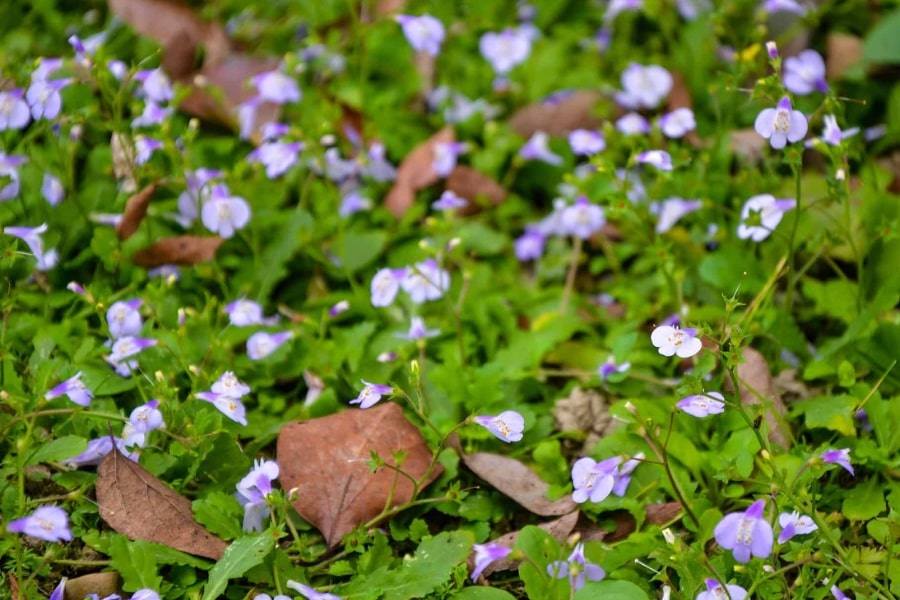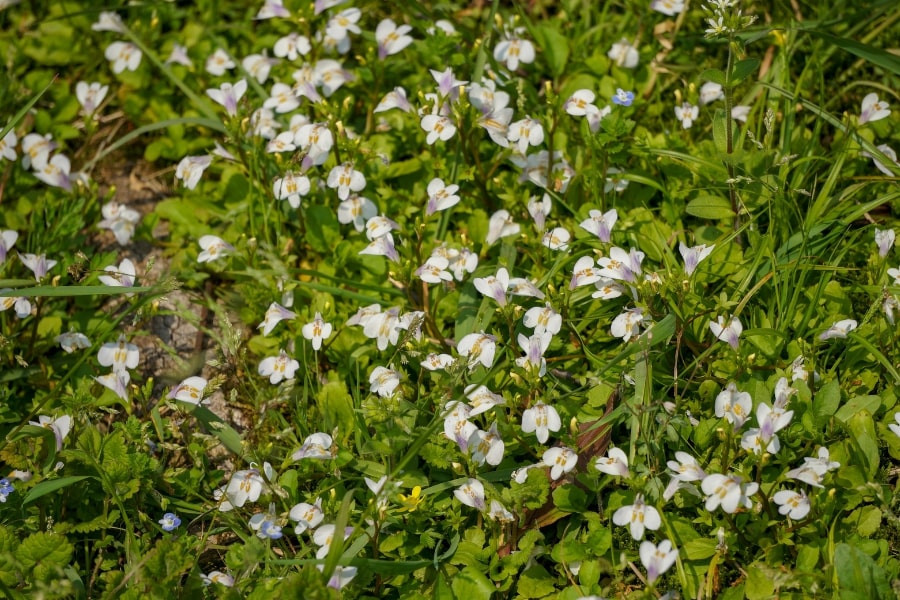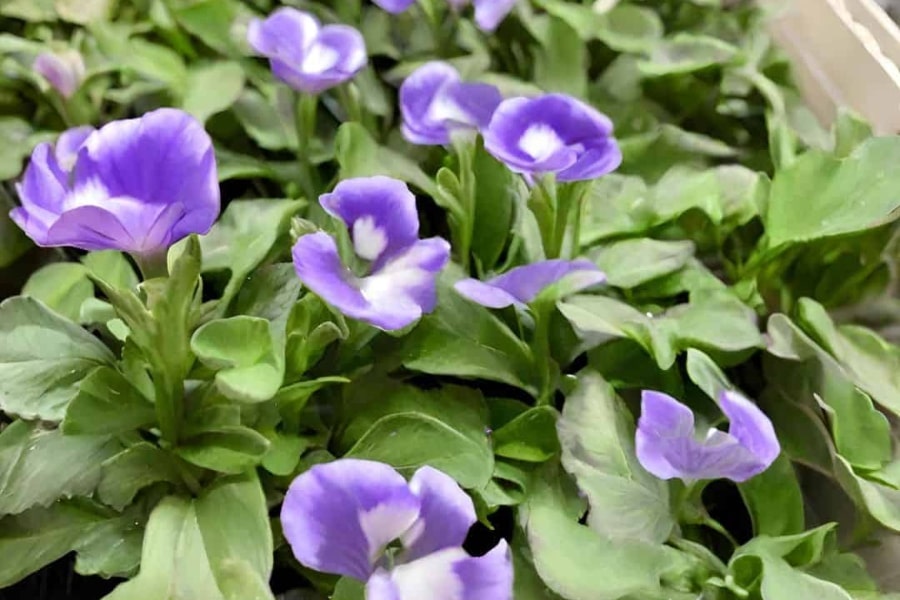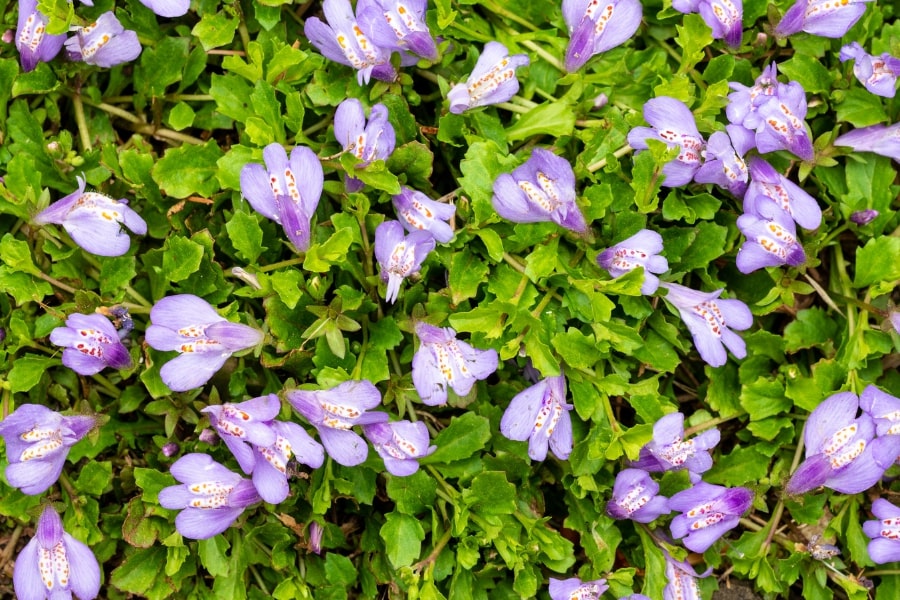Mazus is a charming little genus of flowering plants in the Mazaceae family, best known for its delicate beauty and surprising toughness. With roughly 20 species scattered mostly across Asia—and a few making their home in North America—this plant has adapted to thrive in a variety of landscapes. Its standout member, creeping mazus, forms a lush, ground-hugging carpet dotted with intricate foliage and cheerful blooms that brighten any shady corner. Gardeners often fall in love with Mazus for its ability to weave effortlessly between stones, paths, and borders, softening hard edges with living color. But it’s not just a pretty face—Mazus also helps stabilize soil, prevent erosion, and create tiny habitat pockets for pollinators and beneficial insects. It’s one of those plants that quietly works hard while also provide aesthetic appeal.

Our Selection of Mazus
At Martin Garden Center, we have grown Mazus reptans (Blue) and Mazus alba (White). The majority of our Mazus in 4″ containers comes from our regional vendors who almost exclusively grow the Mazus blue. We see our first containers of Mazus in the early spring and then see them every 6-8 weeks from our vendors. We do not guarantee stock at all times, but it is consistently available in the Spring, Summer, and into the Fall.
How to Grow & Cultivate Mazus
Whether planted in full sun or partial shade, Mazus adapts well, making it a versatile choice for various garden settings. Adequate sunlight is essential for optimal flower production, while partial shade can benefit regions with intense heat. When selecting a location, gardeners should also factor in Mazus’ spreading habit, ensuring it has enough space to cascade and form its characteristic low-growing carpet.
Preparing the soil is crucial for the successful cultivation of Mazus. Mazus thrives in well-drained soil; soil that retains moisture without becoming waterlogged is ideal. Amending the soil with organic matter can enhance fertility and improve drainage. Watering newly planted Mazus is essential to help establish a strong root system. Mulching around the plants can aid in retaining moisture and suppressing weeds.
Once established, Mazus is generally a low-maintenance plant. No deadheading is needed as Mazus is self-cleaning. Regularly trimming the edges can help maintain the desired shape and prevent Mazus from encroaching on neighboring plants or pathways. Gardeners should also keep an eye on any signs of self-seeding, as Mazus can be prolific in spreading through seeds. If necessary, removing excess seedlings can prevent unintended colonization. Pruning is best done after the flowering period to ensure the plant’s energy is directed toward establishing a robust root system.
While Mazus is relatively hardy, periodic inspection for pests and diseases is advisable.

Leaves and Flowers
The leaves are typically lance-shaped with a rich green hue and arranged oppositely along the stems, providing a lush and vibrant backdrop to the delicate flowers. Serrated edges characterize the foliage, adding an intricate texture that enhances the visual interest of the plant. The leaves of Mazus, particularly in the case of creeping mazus (Mazus reptans), form a dense carpet as the plant spreads, creating a verdant tapestry that covers the ground.
The flowers of Mazus have a tubular form with five petals and come in a range of colors, including shades of blue, purple, and white. The blossoms are arranged in clusters, creating a visually striking effect against the backdrop of the lush green foliage. The flowering period varies depending on the species and environmental conditions but generally occurs in late spring to early summer. Its charming flowers attract pollinators such as bees and butterflies, contributing to the broader ecosystem by supporting the reproduction of other plant species.

Uses in Gardening and Landscaping
Mazus, with its low-growing and spreading nature, offers a range of landscaping possibilities. As a ground cover, it can be used to create a living carpet that suppresses weeds and adds visual interest to open spaces. The vibrant colors of mazus flowers contribute to the overall aesthetics of the garden, providing a striking contrast to other plants or hardscape elements.
In rock gardens, Mazus reptans can find a harmonious home nestled between rocks and boulders, softening the edges and adding a touch of natural beauty. The adaptability of mazus to different soil types makes it an excellent candidate for areas where other plants might struggle to establish themselves. Its hardiness also makes it suitable for slopes and embankments where erosion control is a concern. In the Upstate, Mazus is a herbaceous perennial, although its foliage remains as a mat until new foliage pokes through in the Spring.

Frequently Asked Questions
Is Mazus Invasive?
Mazus, particularly Mazus reptans (Creeping Mazus), has the potential to be invasive in certain conditions. While many gardeners appreciate its vigorous spreading habit for ground cover and erosion control, its ability to form a dense mat of foliage can lead to overgrowth and potential invasiveness.
Is Mazus Toxic to Cats and Dogs?
Limited information is available regarding the toxicity of Mazus plants to cats and dogs. No well-documented cases of severe toxicity are associated with Mazus ingestion by pets. However, if you suspect that your dog has consumed Mazus or any other plant and is exhibiting signs of distress, contact your veterinarian promptly.
Is Mazus A Perennial?
Mazus is a genus that includes several species of low-growing, herbaceous perennials. As a perennial, Mazus will go through periods of dormancy during the winter months and then regrow in the spring, producing new foliage and flowers. Its ability to return year after year makes it a durable and reliable choice for gardeners looking to establish long-lasting ground cover or add a low-maintenance perennial to their landscapes.
